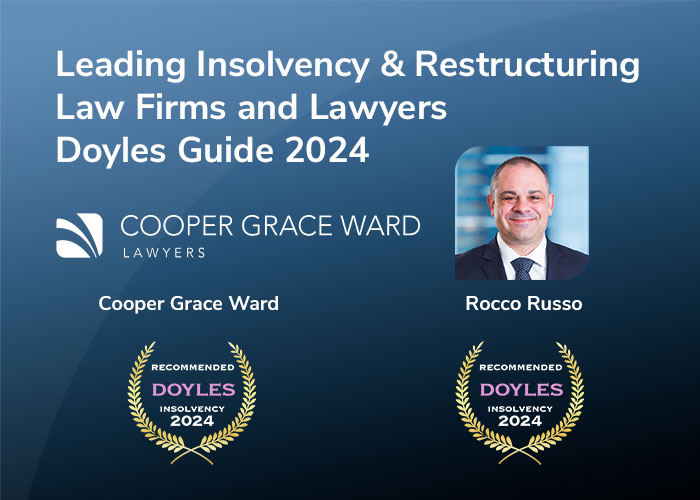The recent decision of the Federal Court in Carter in the matter of Damilock Pty Ltd (Damilock) highlights the need for liquidators to review current practices when paying priority creditors (e.g. employee entitlements).
Facts
The plaintiffs were appointed as administrators of Damilock on 26 June 2007 and subsequently appointed as liquidators by creditors’ resolution at a meeting on 7 September 2007.
Damilock’s first ranking secured creditor was ANZ, having had a fixed and floating charge over the company’s assets and liabilities since 1986. At the time of the administration, ANZ was owed approximately $1.6 million and, after pursuing and realising claims against guarantors of the debt, ANZ was owed $1.154 million, excluding interest of $500,000. The second ranking secured creditor was owed approximately $900,000 and unsecured creditors were owed approximately $17 million.
With the approval of ANZ, $612,000 worth of employees’ entitlements for wages, superannuation contributions, leave entitlements, entitlements on account of retrenchment benefits and superannuation guarantee charges owed by the company were paid out of charged property. In addition, one of Damilock’s furniture stores still trading in South Australia assumed a liability for employee entitlements for $132,000.
The plaintiffs continued to realise the available assets of the company. The plaintiffs investigated various transactions and recovered $342,000, after paying relevant legal and collection costs, on the basis that the transactions were unfair preferences and voidable transactions pursuant to section 588 FE of the Corporations Act 2001 (Cth) (Act). There was also a sundry GST refund for $12,000, which the plaintiffs collected and was available for distribution among Damilock’s creditors.
The liquidators of Damilock applied to the Federal Court for a determination pursuant to section 511 of the Act, as to whether they should pay the amounts recovered by the company in respect to the unfair preference claims to the company’s unsecured creditors, or alternatively directly to ANZ as first ranking secured creditor.
Justice Mansfield relied exclusively on the reasoning of Justice Finkelstein in Cook, Re; Italiano Family Fruit Company Pty Ltd (Cook) on the basis that the facts were ‘on all fours’ with the current case in Carter.
What happened in Cook?
Facts in Cook
As in the current case, the liquidators of Italiano Family Fruit Company Pty Ltd had conscientiously realised the available assets of the company, and there were extensive secured and unsecured creditors. From the realised assets subject to NAB’s charge, the liquidators used the charged funds to discharge debts owed to employees pursuant to section 561 of the Act, without seeking NAB’s prior consent. The liquidators later recovered a small amount by way of preference claims and at issue was how the liquidators of the company should have applied the amount. That amount would have meant a very small distribution to the unsecured creditors, or alternatively a reduction of the liability of the company to its secured primary creditor, NAB.
Decision in Cook
Does a fixed and floating charge cover preference payments?
The question of whether preference recoveries belong to the secured or unsecured creditors has been considered in numerous cases in Australia and other common law countries over many years.
Justice Finkelstein considered the ongoing applicability of the High Court’s decision in N A Kratzmann Pty Ltd (in liq) v Tucker (No 2), which, until legislative reform to the Companies Law in 1992, was the leading Australian authority on the nature and treatment of preference recoveries. The High Court in Kratzmann drew a distinction between the recovery of specific and identifiable property (to which a charge could be attached) and the recovery of money (which was not subject to a charge).* In Kratzmann the High Court held that, because a charge could not attach to recovery of money, preference recoveries were to be applied by the liquidator for the unsecured creditors rather than the secured creditors.
His Honour concluded that the decision in Kratzmann rests on ‘uncertain and, perhaps, unsound rules and distinctions’. Justice Finkelstein considered that the question of whether a charge should attach to preference recoveries ought not depend on the nature of the property recovered, thereby favouring a different approach to the High Court in Kratzmann.
Justice Finkelstein considered the position to be in need of parliamentary clarification, but surmised the preferred view as being:
- preference proceeds are the property of the company;
- the liquidator can sell the proceeds; and
- the liquidator can claim general costs and expenses of the winding up and his or her remuneration out of preference proceeds because they are property of the company.
Alternatively, should NAB’s claim to the recovered preferences be subrogated to the employee entitlements claims?
The basis for this suggestion was that, if the employees’ claims had been paid after receipt of the preference proceeds, the employees would have had priority and been paid rather than the NAB.
The Court noted that there were two circumstances in which employees are paid out of floating charge assets; those provided for in sections 561 and 433 of the Act. Section 561 refers to section 556, which gives priority to employees over a secured creditor for certain debts owed in a winding up. Section 433 relates to an obligation upon a receiver appointed by a debenture holder to pay out of property in the receiver’s hands certain debts in priority to any claim for principal or interest owing to the appointing debenture holder. The priority debts referred to in both provisions include priority payment of employee entitlements.
As the case concerned a liquidator rather than receiver, the Court focussed on section 561 and considered that the right of employees to have recourse to charged assets under that section was conditional on there being insufficient uncharged property of the company available to meet preferential debts.
This raised the question of when such an assessment is to be made. Justice Finkelstein held that there is to be only one assessment of the sufficiency of a company’s assets and that is to be made when enough is known about the company’s affairs. His Honour considered that an assessment must take into account all actual and potential realisations. His Honour said a liquidator should not make an interim assessment of the company’s financial position.
The Court noted that as a result of the operation of section 561 and the associated duty on a controller of floating charge assets to pay priority debts if conditions are satisfied, a liquidator who has realised such assets retains the proceeds as a trustee. The proceeds are to be held on trust for the secured creditor until it is determined whether the company’s free assets are insufficient to meet priority debts.
In Cook, priority claims were paid out of floating charge assets before there was satisfaction of the condition that would make those assets liable to meet the debts of priority creditors. Moreover, the payments were made without the bank’s consent. The floating charge proceeds should not have been applied to meet the priority debts and as a result the liquidators committed a breach of trust. NAB’s loss in this instance was equal to the value of the free assets that eventually became available to meet the priority claims.
Justice Finkelstein suggested that this could be avoided where a liquidator obtains the informed consent of a secured creditor before paying out the priority creditors, on the basis that the secured creditor is subrogated to those priority creditors.
Justice Finkelstein continued this line of thinking and held that, as the bank’s funds had been misapplied in breach of trust, the bank should be subrogated to the rights of priority creditors who have been paid out with the bank’s funds. Without the right of subrogation being granted, the company and its unsecured creditors would unconscionably benefit from a windfall produced by breach of trust.
In Cook, the judge gave directions that the liquidators pay the balance of the amounts recovered from settlements of unfair preference claims to NAB, the secured creditor of Italiano Family Fruit Pty Ltd.
So, what happened in Damilock?
In Damilock, Justice Mansfield concluded, as Justice Finkelstein did, that the primary secured creditor was entitled to receive the amount recovered from unfair preference claims.
In summary
- Liquidators should exercise caution before paying out employee entitlements and other priority creditor debts from charged assets.
- To make a priority distribution from money caught by a secured creditor’s charge, a liquidator must make a determination that there will not be enough ‘non-charged’ assets to pay priority creditor debts.
- Liquidators should ensure that any assessment as to the sufficiency of a company’s realised assets to enable payment of employee entitlements takes into account all actual and potential realisations.
- Where doubt arises, liquidators should seek the consent of the secured creditor.
- Where the secured creditor provides consent, then according to the decision in Damilock, it will generally obtain a right of subrogation to the rights of the priority creditors paid.
- Whether a secured creditor’s fixed and floating charge captures recovered unfair preference claims remains to be finally determined in Australia. The decision in Kratzmann appears dubious in light of Cook and Damilock, and must remain so until the High Court clarifies the position.
References:
* Zaki, M, and Jacobs, W, “Are secured creditors entitled to the (Italiano) fruits of successful unfair preference actions?”, 2011, Insolvency Law Bulletin, March 2011, pp 129-130




